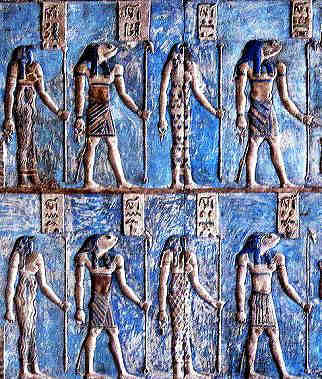by
Given the commonality of flood legends
amongst nations great and small alike, it comes as a surprise to read the view
of scholars that important Egypt did not have such a legend.
David Fasold, however, claimed (in
The Discovery of Noah's Ark) to have found such a flood legend
in ancient Egyptian mythology.
Nations
throughout the world share a legend of a universal Flood and of a righteous man
saved with his family in a boat of some kind. Surely this points to a common
ancestry amongst even the most diverse and far-flung peoples?
Given the
prominence in early Egypt of Joseph and Moses, with their toledôt records, we should expect to find Flood legends in the
sophisticated Egyptian mythology as well. Strangely, ancient Egypt is thought
by some to be one of the few nations in which memory of a universal Flood has
not been preserved.
David
Fasold (The Discovery of Noah’s Ark, Sidgwick and Jackson, London, 1990)
thinks otherwise, pointing out that the begetter of the ‘gods’ of Egypt was Nu
[var. Nun], a name not dissimilar to Noah. Moreover, the original gods of the
Egyptian pantheon were 8 in number; 8 being also the number (of primary progenitors)
saved in Noah’s Ark (cf. Genesis 7:13 and 2 Peter 2:5). According to
Fasold (, pp. 16-17):
A closer
approximation to the Noah of the Genesis account is hard to imagine. In this
regard Noah was the preserver of the seed of mankind .... Noah, or Nu, being
one with the original eight gods of the Egyptian pantheon also accounts for Nu
being the progenitor of the father of their civilization. These eight were
viewed as gods by having passed through the judgment and survived as well as
their longevity, which their offspring did not inherit to the same extent’.
In light
of Sir Wallis Budge’s view that Nu represented the watery mass from which the
gods evolved, Fasold added: “It takes little imagination to view Nu as directly
connected with the watery mass of the Flood, and the 'bark of millions of years’
as the Ark from ancient times, with the ‘company of gods’ as the survivors”.
The ‘goddess’
Nut, mother of all the living, who accompanied her husband Nu on the voyage,
must then stand for Noah’s wife. Nut was also held in high esteem among the
gods.
This may not be the only Egyptian version of the
Flood. For another possible example, see professor A Yahuda’s The Language
of the Pentateuch in its Relation to Egyptian, Oxford UP, 1933, 209-211.

